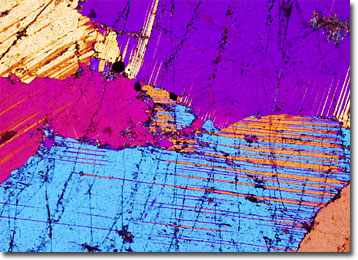Polarized Light Microscopy Digital Image Gallery
Anorthosite
Found on both the moon and the Earth, anorthosite is an igneous rock primarily comprised of plagioclase feldspars. The name of the rock stems from the Greek an and orthos, which together mean “not upright,” a reference to the slanting form of the plagioclase crystals it contains.

View a second image of Anorthosite
On Earth, anorthosite is not as common as basalt or granite and is composed of coarse crystals. Large masses of anorthosite, however, do occur and can be found in such locations as the New England region of the United States, Zimbabwe, and Canada. A particularly large and well-known series of anorthosite complexes occurs in the Adirondack Mountains and is referred to as the Adirondack Fe-Ti deposits. This term is reflective of the iron and titanium ores that may be readily mined from the rock complexes in the form of ilmenite, magnetite, rutile, and hematite. Anorthosite is also sometimes quarried for use as crushed rock or as a building material.
Lunar anorthosite, which was first obtained by humans through the Apollo space missions, may appear in either a coarse or finely crystalline form. White in color and relatively reflective, large accumulations of anorthosite are what give the lunar highlands a light appearance to those viewing them from the Earth. These highlands are believed to represent the earliest crust of the moon, and anorthosite samples from them have been dated at more than 4 billion years old.
